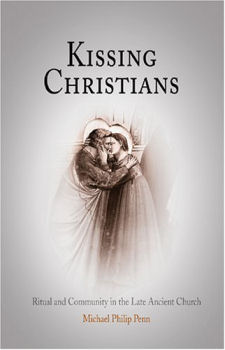
|
Posted December 6, 2005
Book: Kissing Christians: Ritual and Community in the Late Ancient Church Author: Michael Philip Penn University of Pennsylvania Press, Philadelphia, 2005, pp. 186 Excerpt from the Jacket:
Christians kissed each other during prayer, Eucharist, baptism, and ordination and in connection with greeting, funerals, monastic vows, and martyrdom. As Michael Philip Penn shows in Kissing Christians, this ritual kiss played a key role in defining group membership and strengthening the social bond between the communal body and its individual members. Kissing Christians presents the first comprehensive study of the ritual kiss and how controversies surrounding it became part of larger debates regarding the internal structure of Christian communities and their relations with outsiders. Penn traces how Christian writers exalted those who kissed only fellow Christians, proclaimed that Jews did not have a kiss, prohibited exchanging the kiss with potential heretics, privileged the confessor’s kiss, prohibited Christian men and women from kissing each other, and forbade laity from kissing clergy. Kissing Christians also investigates connections between kissing and group cohesion, kissing practices and purity concerns, and how Christian leaders used the motif of the kiss of Judas to examine theological notions of loyalty, unity, forgiveness, hierarchy, and subversion. Exploring connections between bodies, power, and performance, Kissing Christians bridges the gap between cultural and liturgical approaches to antiquity. It breaks significant new ground in its application of literary and sociological theory to liturgical history and will have a profound impact on these fields. An Excerpt from the Book: The romance Joseph and Aseneth provides one of the most explicit examples of a kiss’s purity being used as a means of exclusion, transformation, and inclusion – a pattern very reminiscent of Arnold van Gennep’s discussion of rites of passage and Victor Turner’s examination of ritual as social drama. According to Genesis 41:45, Pharaoh married Joseph to Aseneth, the daughter of the Egyptian high priest Penephres. The verse presented later generations with an interpretive dilemma: How could Joseph, an examplar of Jewish piety, marry the daughter of a pagan priest? Joseph and Aseneth answers this question by telling the story of Joseph’s courtship of Aseneth and, most important, Aseneth’s conversion to Judaism before they marry. . . . Joseph links a kiss’s acceptability to the role of the mouth in ritual. Blessing, eating, and drinking all involve the mouth; to kiss one who blesses, eats, and drinks not form the table of the true God but from idols [as had Aseneth] becomes, for Joseph, inconceivable. . . .Joseph suggests that kissing can transmit impurity. In this case, the mouth becomes polluted through its involvement in idol worship, and kissing can spread this contagion. . . . Rejected by Joseph’s refusal to kiss her but encourage by his prayer for her conversion, Aseneth . . .fast and repents for seven days, [and] the chief angel visits Aseneth and helps convert her to Judaism. Just as the mouth’s connection with purity played an integral role in Joseph’s initial rejection of Aseneth’s kisses, so does Aseneth’s conversion focus on the mouth’s purity. . . . Informed of Aseneth’s conversion, Joseph returns to Pentephres’s house [Aseneth’s father]. On seeing one another, Joseph and Aseneth “kissed each other for a long time and both came to life in their spirits. And Joseph kissed Aseneth and he gave her spirit of life and he kissed her a second time and gave her spirit of wisdom and he kissed her a third time and gave her spirit of truth. Like many other ancient references to kissing, Joseph and Aseneth states that a kiss transfers spirit and binds individuals together. The kiss that earlier divided Joseph and Aseneth now unites them. Later in the story, when Pharaoh presides over Joseph and Aseneth’s marriage, he also uses the kiss to confirm this union as he “brought them mouth to mouth and joined them by their lips, and they kissed each other.” Table of Contents: 1. Kissing basics 2. The kiss that binds: Christian communities and group cohesion 3. Difference and distinction: the exclusive kiss 4. Boundary violations: purity, promiscuity, and betrayal Conclusions |
|
